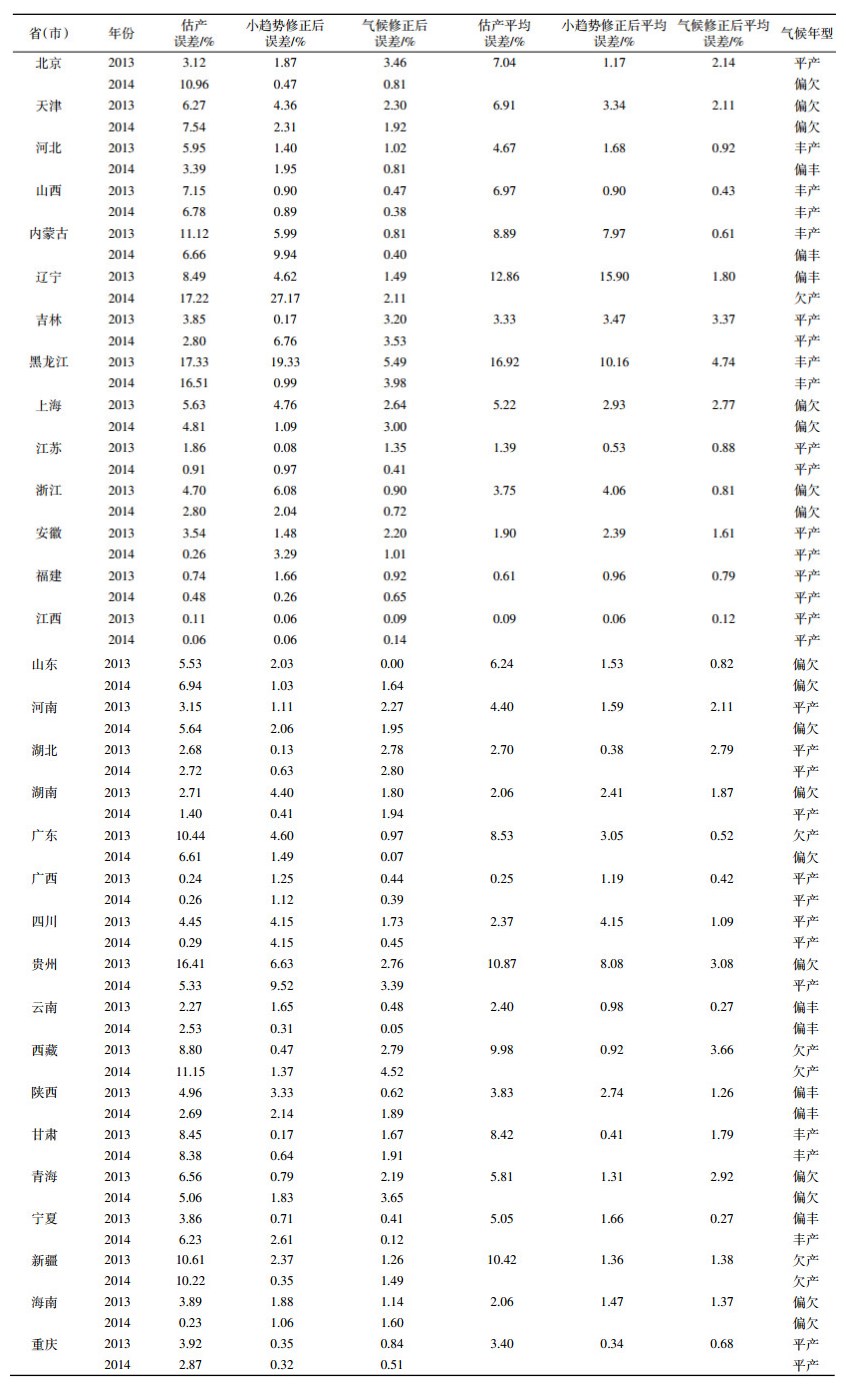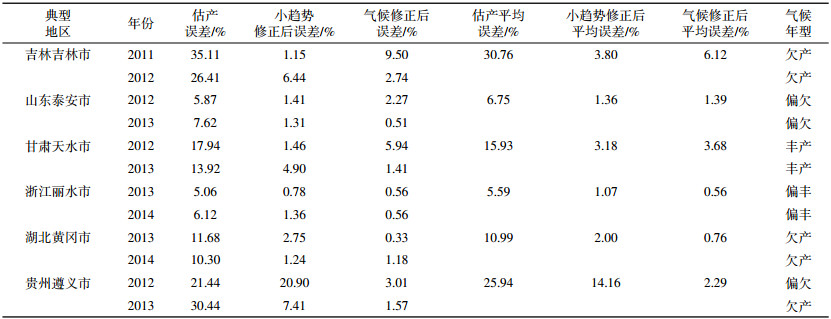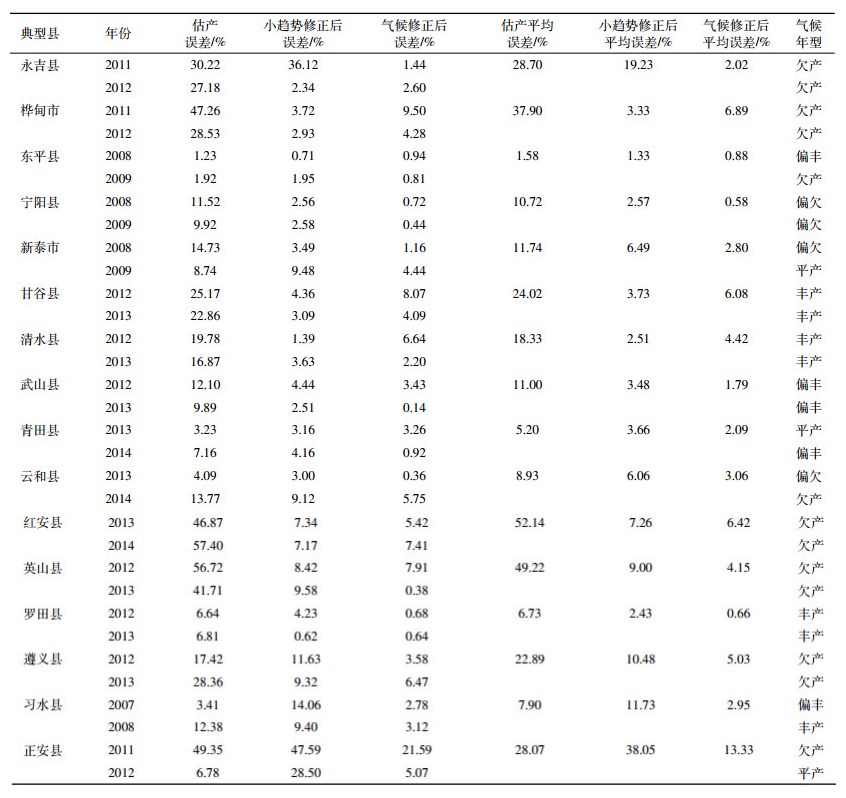文章信息
- 郑宏艳, 李敬亚, 刘书田, 黄治平, 米长虹, 侯彦林, 王农, 蔡彦明, 王铄今, 侯显达
- ZHENG Hong-yan, LI Jing-ya, LIU Shu-tian, HUANG Zhi-ping, MI Chang-hong, HOU Yan-lin, WANG Nong, CAI Yan-ming, WANG Shuo-jin, HOU Xian-da
- 粮食估产的“通道-概率模型”的验证
- Verification of “Channel-Probability Model” of Grain Yield Estimation
- 农业资源与环境学报, 2016, 33(4): 390-396
- Journal of Agricultural Resources and Environment, 2016, 33(4): 390-396
- http://dx.doi.org/10.13254/j.jare.2015.0194
-
文章历史
- 收稿日期: 2015-08-11
2. 北京农业信息技术研究中心, 北京 100089;
3. 北京优雅施软件研发服务中心, 北京 100089
2. Beijing Research Center for Information Technology in Agriculture, Beijing 100089, China;
3. Software Development and Service Center of Beijing Yours, Beijing 100089, China
粮食产量预测包括短、中、长期生产潜力预测和当年估产2部分,笔者基于粮食产量历史数据建立了粮食生产潜力预测和估产的理论、方法,并应用一些案例进行了初步验证[1, 2, 3, 4, 5]。本文应用全国、31个省(以下将省、自治区、直辖市统称为省,下同)、6个典型地区和16个典型县(以下将县、市、区统称为县)数据对粮食估产的“通道-概率模型”进行了系统性验证和讨论。
1 材料与方法 1.1 数据来源从统计年鉴中整理出全国、31个省(区、直辖市)、6个典型地区和16个典型县多年粮食单产数据,建立数据库,包括行政单元名称、年代、单产、总产、播种面积等指标。
1.2 粮食估产的“通道-概率模型”估产方法和步骤参考文献[4],其中第(8)步为连续逐年预测时可使用前一年估产误差作为小趋势误差修正参数[2],即公式Y潜修=Y潜*(1-前一年预测误差%),而气候年型估产的误差为e气修=(最接近当年产量的气候年型产量-当年产量)/当年产量*100%。计算平均误差时均将误差进行绝对值操作后计算。
2 结果与讨论 2.1 国家级验证以全国1979—2014年单产数据为研究对象,其中1979—2011年用来建模,2012—2014年用来验证,结果见表 1。
 |
表 1结果说明全国粮食估产与实际产量误差低于3%,小趋势修正后2013年误差0.19%,气候修正后误差1.04%。而2014年预测误差为0.82%,小于1%,精度较高,小趋势修正后误差为1.56%,气候修正后误差为0.84%,大于未修正误差,这主要为全国尺度地域间气象条件对产量影响的互补性,原则上可以不使用小趋势误差修正和气候年型修正。根据实际产量与当年各年型产量的比较,2013年气候偏丰年,2014年为气候平产年。
为更好地分析估产精度,现定义以下估产精度分级标准,见表 2。
由表 1可知,国家级尺度上应用“通道-概率模型”进行估产精度高。
2.2 省级验证参照1.2的研究方法对各省进行了验证,结果见表 3。
表 3结果说明各省粮食估产量与实际产量误差大多在10%以内,少数在10%上下,极个别的达到了15%左右,如2014年辽宁省。据2014年辽宁省国民经济和社会发展统计公报[6],辽宁省受自1951年以来最严重的旱灾影响,2014年全年粮食总产量1 753.9万t,比2013年减产441.7万t,下降20.1%,由于重大灾害影响,使得辽宁省的预测结果偏高。因此,估产误差较大时,应进行小趋势修正和气候年型修正。
 |
根据表 2,将各省的估产精度分布列于表 4。
修正前估产精度合格率为51.61%,利用小趋势修正后精度合格率为87.10%,精度得到显著提高,而经过气候修正后估产合格率达到100%,这说明省级估产同处一个气候区,气象条件对产量影响的互补性不强,应用气候年型修正可以进一步提高估产精度。
2.3 典型地区验证参照1.2的研究方法对各典型地区进行了验证,结果见表 5。根据表 5,将典型地区估产精度分布列于表 6。
 |
 |
表 5和表 6结果说明各典型地区的估产误差高于5%,精度低,主要由于地区级地域间气象条件对产量影响的互补性小,原则上要使用小趋势修正和气候年型修正,经过小趋势修正后,除遵义市估产精度不合格外均合格,总的精度合格率为83.33%,经气候修正后,除吉林市不合格外均合格,总的精度合格率为83.33%,表明使用小趋势修正和气候年型修正可以显著提高预测精度。遵义市估产精度低主要为遵义市部分地方的旱地作物和无水源灌溉的稻田,出现了较重旱象,造成粮食产量损失12.4万t[7],遵义市2011年属超欠年,致使2012年估产误差和修正后估产误差都偏高。
2.4 典型县验证参照1.2的研究方法对各典型地区的县进行了验证,结果见表 7。
 |
根据表 7,典型县估产精度分布见表 8。
 |
表 8结果说明县级估产单元的空间尺度比地区级的空间尺度还要小,所以县级地域间气象条件对产量影响的互补性更小,这样使得预测误差较大,修正前估产精度合格率为0%,小趋势修正后估产精度合格率为43.75%,气候年型修正后估产精度合格率为68.75%,精度得到很大的提高。以上结果说明,县级估产还必须结合作物长势和专家经验进行进一步地修正。
3 讨论 3.1 关于估产误差国家级估产由于地域空间尺度足够大,包括不同气候区,气象条件对产量影响的互补性很强,所以估产误差小,因此国家级可以不使用小趋势修正和气候年型修正。省级估产由于同处一个气候区,气象条件对产量影响的互补性不强,必须使用小趋势修正和气候年型修正。地区级和县级由于空间尺度更小,在使用小趋势修正和气候年型修正基础上,应该根据作物长势和专家经验进行进一步地修正。
3.2 关于小趋势修正小趋势修正有2个公式:当预测误差小于10%时,使用Y×(1-K)修正;当预测误差大于10%时,使用Y/(1+K)修正。
3.3 关于估产精度和气候年型估产单元气候年型可以自动划分,一般分为5级年型即丰产年、偏丰年、平产年、偏欠年、欠产年表示估产年型;波动大的估产单元可以使用7级,即超丰年、丰产年、偏丰年、平产年、偏欠年、欠产年、超欠年,其中超丰年和超欠年的修正参数必须根据作物实时长势和实时气象条件具体确定。
由于本项研究不是实时估产,无法计算当年估产精度;作为基于历史数据的估产方法的验证,本研究使用估产值和历史年的真实数据计算估产误差和精度。结果表明:(1)“通道-概率模型”可直接进行国家级估产,估产精度高;(2)省级估产使用小趋势修正和气候年型修正,估产精度也很高;(3)地区级估产使用小趋势修正和气候年型修正可以显著提高估产精度;(4)县级估产在小趋势修正和气候年型修正基础上,还必须增加根据作物适时长势和专家经验的修正。
4 结论通过大量案例的实证,证明了所建立的“通道-概率”估产理论和方法是科学的、实用的和准确的;小趋势修正和气候年型修正是“通道-概率”模型的一部分,可以显著提高估产精度,县级估产还必须增加根据实时作物长势调查和当地专家经验进行修正。
| [1] | 侯彦林, 郑宏艳, 刘书田, 等. 粮食产量预测理论、方法及其应用Ⅰ. 科技进步增产理论、模型及其应用[J]. 农业资源与环境学报, 2014, 31(3):205-211. HOU Yan-lin, ZHENG Hong-yan, LIU Shu-tian, et al. The theory, method and its application of the grain yield forecastⅠ. Theory, model and its application of scientific and technological progress in increasing grain yield[J]. Journal of Agricultural Resources and Environment, 2014, 31(3):205-211.(in Chinese) |
| [2] | 郑宏艳, 刘书田, 王铄今, 等. 粮食产量预测理论、方法与应用Ⅱ. 粮食生产潜力短期预测理论、模型及其应用[J]. 农业资源与环境学报, 2014, 31(3):212-219.(in Chinese) ZHENG Hong-yan, LIU Shu-tian, WANG Shuo-jin, et al. The theory, method and its application of grain yield forecast Ⅱ. The theory, method and its application of short-term forecast of the grain yield potential[J]. Journal of Agricultural Resources and Environment, 2014, 31(3):212-219.(in Chinese) |
| [3] | 刘书田, 王铄今, 米长虹, 等. 粮食产量预测理论、方法与应用Ⅲ. 粮食生产潜力中、长期预测理论、模型及其应用[J]. 农业资源与环境学报, 2014, 31(3):220-226. LIU Shu-tian, WANG Shuo-jin, MI Chang-hong, et al. The theory, method and its application of grain yield forecast Ⅲ. The theory, method and its application of medium and long-term forecast of the grain yield potential[J]. Journal of Agricultural Resources and Environment, 2014, 31(3):220-226.(in Chinese) |
| [4] | 米长虹, 王农, 黄治平, 等. 粮食产量预测理论、方法与应用Ⅳ. 粮食估产理论、模型及其应用[J]. 农业资源与环境学报, 2014, 31(3):227-232. MI Chang-hong, WANG Nong, HUANG Zhi-ping, et al. The theory, method and its application of grain yield forecast Ⅳ. Theory, method and its application of grain yield estimation[J]. Journal of Agricultural Resources and Environment, 2014, 31(3):227-232.(in Chinese) |
| [5] | 黄治平, 蔡彦明, 王铄今, 等. 粮食产量预测理论、方法与应用Ⅴ. 粮食潜力实现率及其评价方法[J]. 农业资源与环境学报, 2014, 31(3):233-236. HUANG Zhi-ping, CAI Yan-ming, WANG Shuo-jin, et al. The theory, method and its application of grain yeld forecast Ⅴ. The conversion rate of grain yield potential and its evaluation[J]. Journal of Agricultural Resources and Environment, 2014, 31(3):233-236.(in Chinese) |
| [6] | 辽宁省统计局. 二○一四年辽宁省国民经济和社会发展统计公报[EB/OL]. http://www.ln.stats.gov.cn/tjsj/tjgb/ndtjgb/201502/t20150228_595099.html, 2015-02-28. Statistics Bureau of Liaoning Province. Statistical bulletin of national economic and social development in Liaoning Province, 2014[EB/OL]. http://www.ln.stats.gov.cn/tjsj/tjgb/ndtjgb/201502/t20150228_1595099.html, 2015-02-28.(in Chinese) |
| [7] | 遵义市农委. 遵义市2011年旱灾情况报告[EB/OL]. http://www.qagri.gov.cn/Html/2011_08_04/2_47104_2011_08_04_69938.html, 2011-08-04. Agriculture and Rural Committee in Zunyi. Drought situation report in Zhunyi, 2011[EB/OL]. http://www.qagri.gov.cn/Html/2011_08_04/2_47104_2011_08_04_69938.html, 2011-08-04.(in Chinese) |
 2016, Vol. 33
2016, Vol. 33






